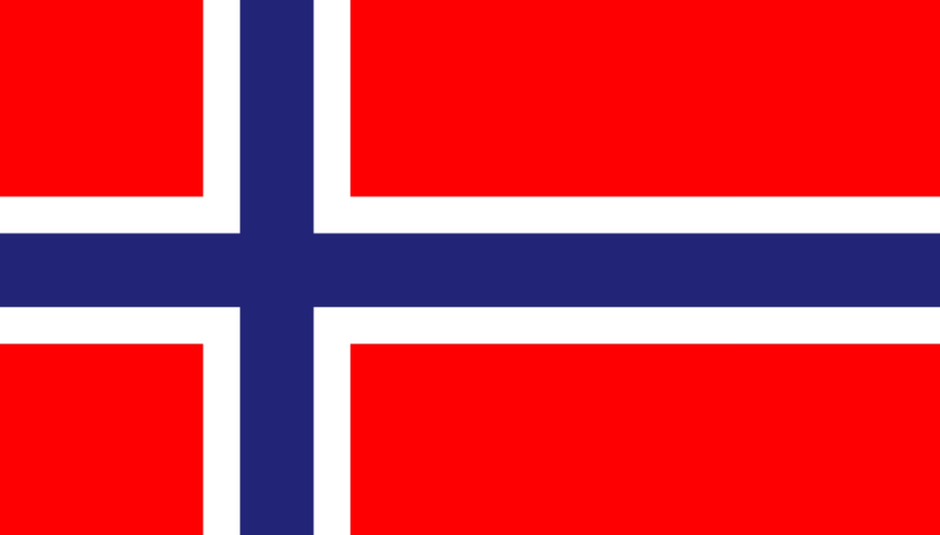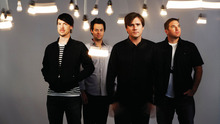It would not be a huge generalisation to say that, a decade or so ago, Norwegian music was most famous for its black metal. Following on from the genesis of that particular branch in the '80s, the scene centred around a few places, with Bergen in particular being a base in the early '90s, and acts like Dimmu Borgir,Mayhem and Burzum — something that didn't end particularly well... — being the focal points. Then, of course, came Mortiis, who seemed to gain a disproportionate amount of airplay on early so-called Alternative Music TV channels well into the 2000s.
But in 2010, although the Norwegian black metal torch still shines darkly — along with a whole group of entertaining, innovative and exciting extreme noise artists and "other metal" fare like Shining, Kvelertak and Årabrot (see John Doran's round-up here) – the artists associated with the country have diversified and their reach has increased. Now names like Kings of Convenience, Annie, Röyksopp and Lindstrøm are more likely to be among the first to crop up along with others, and deservedly so as they've produced and released some of the greatest and most significant records of the past decade, and are worth celebrating in their own right — as has been the diversity to arrive on these shores from across the North Sea.
Norway had perhaps been in the shadow of its eastern neighbour and erstwhile rival, Sweden, a country that has had a perennial spot as one of the world's leading musical exporters, placing third behind the UK and the US. Sweden is a country which has a rich tradition of all things POP and this is an achievement to be celebrated too. There is also little sign of this changing, at least in terms of quality, with Lykke Li about to create a wonderful, varied and hopefully long-lasting recording career for herself. Yet Sweden is a country twice as populous as Norway, and one with a deeply set reputation at shifting music from their shores. No need to name who in particular right now, although one member of that legendary group (hint: it's ABBA) is actually a Norwegian. It's also true that whilst Rednex were a largely fun abomination of a one-hit wonder, Ace of Base did have several great songs. Lest we get sidetracked into Sweden, back westwards.
Music of a great quality did flow at a great rate out Norway and Bergen in the 2000s but making the records was, and still is, barely half the battle. Foreign ears and cold hard cash are both needed to make any real impact on the "greater history of music". It's no surprise, then, to see the country invest so much in its arts and music. Whilst there are a few ready-made receptive markets in their Scandinavian neighbours – although the difficulty in cross-border sales is still a bit of a sticking point – and, to a lesser extent, Germany, the UK remains an important area for Norwegian artists, and it certainly helped Röyksopp garner wider attention and acclaim.
Although their UK singles chart placings were not stratospheric, the fact that they made several marks into the Top 40 says enough. Plus, there are the millions of ears that latched onto 'Eple', following its placement in umpteen-thousand different places on UK television. The same goes for 'So Easy', which handily popped up in a T-Mobile ad and was inevitably re-released, along with the straight-faced Erlend Øye-featuring 'Remind Me'. Their albums didn't fare too terribly either — 2001's Melody AM hit as high as no. 9 in the albums chart and has since gone platinum in their home country, the UK and The Netherlands, whilst all three albums since — The Understanding 2009's Junior and last year's Senior – placed in the Top 40. Tellé Records, an electronic-based Bergen label found in 1998, became the country's label of repute with not just records from Svein and Torbjørn, but Annie, Bjørn 'The Codfather' Torske, Ralph Myerz and even the Finnish experimental-jam troupe Uusi Fantasia.
The digitalisation of the music industry naturally opened up alleys for bands to break into foreign markets, but this also makes the "market" and the whole business of "exporting music" even more competitive and difficult to negotiate. Festivals like Oslo's Øya, Bergenfest and industry event by:Larm put a great premium on the international media and delegates for obvious reasons — no matter the relative wealth, there is only so much music that four-point-something million people can purchase and consume and, along with that, the national self-pride and faith in the music they are producing has to diffuse somewhere.
It's not that Norwegian artists wouldn't go overseas in the past, but their presence at important "industry" festivals — such as The Great Escape, SXSW, and Eurosonic in the Netherlands — is a recognition of this. Although SXSW is an event not short of a band or hundred, there are 18 Norwegian acts taking the trip across the Atlantic, ranging from the pretty-well-established Datarock, to the more emerging acts such as Harrys Gym and Deathcrush.
The act of twinning festivals, as happened with Leicester's Summer Sundae and Bergenfest, is another way in which expansion has been attempted, and successfully so. An article we ran in August last year, based around the current batch of emerging Norwegian talent was picked up by daily newspaper Dagbladet but the size of the music-based media in the country is small, hence the importance "export". That Norway is also home to some of the most remote festivals in the world (see Trænafestivalen way up in the North) with midnight sun also helps drag a few more foreigners over.
That's where Music Export Norway (MEN) comes in. MEN was established in 2000 by the five main music industry organisations in the country, with the broad aim being to support those artists with enough quality and potential to break out of Norway and plough their furrows elsewhere. The clue is in the title, really. As well as the main office in Oslo, MEN opened its first foreign office in 2008 in London with Jonas Vebner at the helm, followed in June this year by another in Berlin, covering bases in two of their "priority markets".
It is easy to hold the perception that music export offices just throw money and hope that something sticks, especially given the state of the Norwegian economy. The strength of the currency has its downsides, too, given that the payment will be in Euros, Pounds or whatever outside of Norway, so it is a case of monetary swings and roundabouts. The North Sea oil reserves certainly help — the MEN logo is a recognition of this — but the more important aid provided is far more than just financial, helping out rising artists with things like arranging travel support, particularly for those who have been invited to play the key international industry showcases mentioned above.
Pål Dimmen, Communications Officer for MEN, expands on what the monetary situation is for the organisation:
"It is not like one big pot of money that gets divided but rather a lot of different places where you as an artist may apply for support. The Foreign Ministry provides travel support through the Music Information Centre, the Arts Council Norway provides support for recording music and tour support, Fund for performing artists provides funding for projects in which professional performing artists participate and for recordings made in Norway."
This year a new program was introduced, which will fund two individual Norwegian music projects per year. Each project is eligible to receive up to 300,000 Norwegian Kroner (NOK) (£32,400) per year for a period of up to three years, and is open to all music industry organisations and individuals from labels to production companies and management, not just artists. That's not all, though. There's also an ad-hoc program where another 300,000NOK is allocated for several current projects, limited to 50,000NOK per project. There's a lot of work still to be done — but it is estimated that stipends from the various government and artist support organisations has increased by 154% from 1999-2009, even with inflation adjustment taken into account.
Although there are cases of bands who speak in their native tongue making waves internationally, like Casiokids, it will impact the international potential, but is "making it" abroad a necessity in order to make a living solely from music? Dimmen doesn't necessarily think so.
"The biggest acts in Norway can make a very decent living, both from records sales, radio airplay and especially touring. A band like Kaizers Orchestra, which sells out huge tours and do well on the charts, probably have a good income – especially the songwriter." He adds, "Like everywhere else, the safest income comes from gigs these days, so I guess if you can be on the road for months at a time you should be able to do fairly well."
Naturally and traditionally, the first move would have been to become an established act on home shores first before moving elsewhere, having created a base from which to launch. This is increasingly not the case, with more and more acts finding success and acclaim abroad first. One of the reasons for this Dimmen believes can be attributed to the ease of online marketing and distribution. "People have realised that it might be just as important to think internationally from the start. The Norwegian market is quite small, so in order to make a living of one’s music one has to look outside the Norwegian borders," he says.
One award-winning Norwegian artist looking to do just that is Susanne Sundfør, who last year released her second album across Scandinavia, co-produced by Lars Horntveth of Jaga Jazzist. Sundfør is certain that the help from the government to the arts is absolutely vital for her and her fellow musicians' careers. "I think that's essential for Norwegian niche music to be supported by the government because Norway is such a small country, we're only five million people," she said. "It's not like if you play in Germany where there are 70 plus million people, there's a much bigger chance that you can make a living playing strange music. But in Norway there's such a small market that you have to be supported to make it."
 Susanne Sundfør by Tonje Thilesen
Susanne Sundfør by Tonje ThilesenWith this trend continuing, it makes complete sense to try and take advantage, pushing Norwegian bands in the direction of the UK, with a little bit of help. There's certainly a rich enough talent pool to choose from, and it was from this that the idea for a Nordic-based music night in London sprung from, organised by MEN's representative in the British capital, Jonas Vebner. The night, christened Ja Ja Ja, ended up as a collaboration with Music Export Denmark, Sweden, Finland and Iceland Music Export and chose The Lexington, in Angel as its base. The night's ethos was very clear from the start, says Vebner:
"The idea behind Ja Ja Ja was to set up a club night and platform to introduce new exciting talent from the Nordic region to a UK audience with a bit more continuity. We make sure the production is up to par, that the show and artist are promoted well and by working with some of the most passionate music lovers in the business as curators – that the line-up is first-rate."
The process is thus: A list of "export ready" Nordic bands is sent to a British curator, who then picks three acts to comprise the line-up. Since the first Huw Stephens-chosen night, curators have included our very own Sean Adams, Steve Lamacq, and Alexander Milas of Metal Hammer magazine plus musical treats from a whole glut of bands from across the region, including Vuk, Ungdomskulen, The Good The Bad, Kvelertak, I Was A King, Harrys Gym, Sudden Weather Change, Snorri Helgason and Katzenjammer. Upon finishing a trial period of six months, the night took a break before resuming in September last year. It has been, it's easily argued, a success.
Yet trying to take over the world using this approach is not necessarily in their minds, at the moment. A cautious approach to expansion outside of London seems to be the wisest way, Vebner thinks.
"We have actually been approached by several promoters from LA, Berlin to Tokyo about taking the night abroad, but we are anxious to pace ourselves and focus on further developing the London night. We really want, and I know this word has become a bit of a cliché, to grow it organically." There has also been discussions for a UK Ja Ja Ja tour, and the idea will be looked at again this year.
 Deer Tracks perform at Ja Ja Ja night - Photo by Anika Mottershaw
Deer Tracks perform at Ja Ja Ja night - Photo by Anika MottershawThe joint venture of Ja Ja Ja has inevitably led to an increasing level of collaboration between the Nordic Export Offices. Together they formed NOMEX, which is used for the organisations to work together in several key areas, with a strategy paper commissioned. That paper, entitled Nordic Music Exports and Music Strategies, does more or less what it says in the title, but as a result of it Kreanord funded a year-long pilot to help test the waters with regards to potential collaboration of an all-Nordic Music Export programme. The five export offices have since formalised the NOMEX project, with an administration now running.
Still, for all this new and exciting music from Bergen, Oslo and elsewhere, you can't have an article of any length on Norwegian music without mentioning a-ha, who recently completed their farewell tour. To celebrate that and to help up-and-coming talent, Magne, Morten and Pål established the a-ha Talent Grant, or more specifically four talent grants, one for each region in Norway. It may sound like an oxymoronic title to some but when put into terms of currency its importance and significance becomes clear. Each regional winner received a total of one million NOK (approx. £110,000), as well as a support slot on the trio's homecoming dates. A once-in-a-lifetime opportunity on the one hand and a very useful sum of money on the other.
The eventual winners could barely be more different. In Bergen's Casiokids you've got bouncy electronica which is seven shades of fun when experienced live, all in a giddy-but-not-sickening excess. Fun for all ages. With Susanne Sundfør, there's a vocalist and songwriter of prodigious talent, whose current batch of morose compositions from The Brothel tie ribbons around your heart and then tug firmly and frequently at your chest. Oslo-based Shining...well, there are few words which can truly do them justice, but their most recent full-length, Blackjazz, is best summed up in one of the record's song titles – 'Blackjazz Deathtrance', which is all-singing all-dancing and contains the sort of pain that's very pleasurable, although the entire thing is a necessary listen.
Sundfør expressed the importance of the grants and said that winning was a great moment and "not just because of the money but because it can do a lot for my career, and I really want to make it outside Norway and spread my wings, which is kind of hard for Norwegian artists to do."
Of course, each individual winner is worthy in their own right and, without seeming too patronising, it's worth a pat on the back for a-ha for investing their own money into the future of their homeland's music and culture. The four winners collectively say a lot more for the health of the Norwegian music industry. Does Sundfør think her fellow winners are a fair representation of where the nation is at the moment? In short, yes.
"I think Shining represent Norwegian music really well, for the jazz scene and also for metal. And Casiokids are very representative of the Bergen scene and just the west coast of Norway in general. Moddi also...there's a lot of great music appearing in the north of Norway like Kråkesolv, who sing in Norwegian. They all have their own genre and all of them are very different but represent Norwegian music quite well," she said. The same can be said about the three Norwegian nominees for the inaugural Nordic Music Prize which includes Sundfør herself along with Kvelertak and Serena Maneesh.
It might be a bit far to call the years 2000-2009 the golden age for Norwegian music, but things can rarely have looked rosier for our Nordic cousins. Although, if you sat down and wrote a list of "Superb Norwegian Records" from this period, you'd probably want to set aside at least an afternoon, if not a whole day. With investment and importantly an increasing number of ears for the vast and varied music of all sorts, you'd have to bet that the number of artists crossing the North Sea and Atlantic will be getting higher and higher.
But looking at it from a purely musical point of view and ignoring all of those more matter-of-fact economic and cultural reasons, the position of Norway's music, and interest in what the country has to offer is only going to grow in the next decade. Already in 2010 we've seen another glut of varied greatness from Diskjokke's En Fin Tid to the returning Röyksopp, Shining, Serena-Maneesh and, quite possibly, another fine collection of cuts from Bjørn Torske. Plus some superbly promising back catalogues already from the more leftfield in Stian Westerhus and Svarte Greiner. The true effects of the music made in this ten-year period and subsequent fertility, along with the continued investment in that sprouting flowerbed, may only materialise in the current decade. And that is very exciting.
Links:
Music Export Norway
Ja Ja Ja Music
NOMEX
by:Larm
Bergenfest
Trænafestival
Nordic Music Prize
by:Larm 2011 runs from February 17-19 and features many a great Norwegian and Nordic band. Myself and Wendy Roby will be there on the cold streets and warm basement venues of Oslo, so expect a review of it all sometime shortly thereafter. The Nordic Music Prize will be unveiled on the Saturday of by:Larm.























